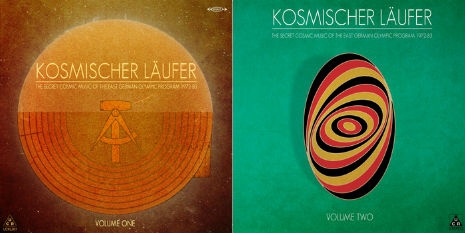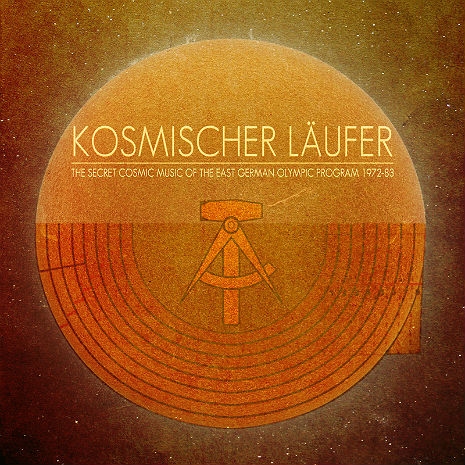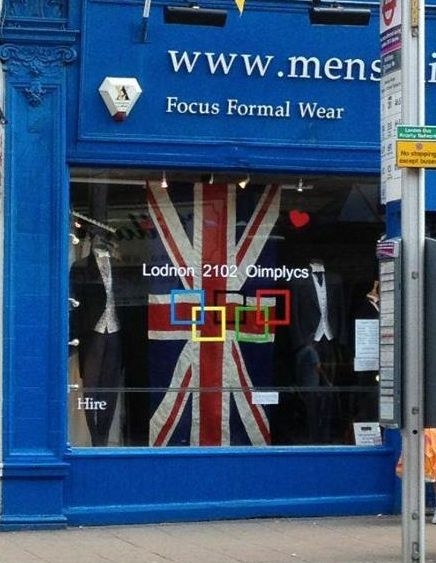
I have to admit, they had me going there for a while…. I thought it was real. I stumbled on the Bandcamp page for the Kosmischer Läufer project two days ago, courtesy of WFMU, who blandly supplied no information about it. The site purported to be the “secret cosmic music of the East German Olympic Program, 1972-1983.” (Kosmischer Läufer means “cosmic runners.”) Volume 1 came out last year, vol. 2 this week.
So I’m listening to these tracks of magnificent 1970s-style German electronic music and taking in the backstory of one Martin Zeichnete, an apprentice sound editor for DEFA (Deutsche Film-Aktiengesellschaft) who, starting in 1972, was transferred to the Olympic training music project, that is, to compose music for East German athletes to train to. Having furtively imbibed the forbidden Western tones of Kraftwerk and Neu! in his hometown of Dresden, Zeichnete managed to smuggle in some avant-garde ideas to the project and generate some pretty sweet Musik that (just by chance) would be tailor-made for the discerning hipster of 2013. Volume 1 represented a program that “should allow the average runner to complete a 5 kilometre run at a reasonable pace. Included are 3 minute warmup and warm down pieces.”

My knowledge of German came in handy, here. There was a puzzlement or two to clear up. The name “Zeichnete,” which means “drew” or “sketched,” isn’t an entirely convincing surname for a German national. The story of being scarily apprehended by the Stasi authorities, only to be suddenly transferred to the Olympic training department, seemed far-fetched. The titles were an absolutely perfect imitation of what the contemporary English speaker would want them to be—“Mausi Mausi,” for Chrissake? “Flucht aus dem Tal der Ahnungslosen” means “Escape from the Valley of the Clueless” and really, that’s a great title in any language and perhaps more to the point, a clue to anyone taking all this retro guff too seriously. The only real problem with it all was that sizable gap between 1989 and 2013. Where were these tracks all this time? What had taken Zeichnete so long? Why was he staggering the releases? Why did some of the tracks sound so perfectly like what a Stereolab-influenced electronic music nut would generate today, given the chance?
More to the point, the whole thing was beginning to seem a bit ridiculous.

Turns out, these fine tracks of faux 1970s e-music had been introduced in a (successfully funded) Kickstarter last year launched by one Drew McFadyen of Edinburgh. (This blog says there’s more than just one person behind it, but I couldn’t discern anyone’s name but that of Mr. McFayden.)
Sehr witzig, mein guter Kerl!
In any case, instead of the most marvelous musical find of this or the last century and an incredible artifact of the Cold War, we have a excellently rendered simulacrum of same. It’s a hoot if you’re in the mood for some free tracks to listen to on Bandcamp or YouTube, but the files can also be ordered on iTunes or Amazon (links to individual tracks are below). Unfortunately, as often happens with Kickstarters, the original run of LPs is sold out. (If you’re listening, Unknown Capability Recordings, remember me if you ever do a future pressing!)
You can read an interview with the fictitious East German, Martin Zeichnete—it’s worth reading, they did a very good job with it. The reference to Andreas Pavel’s Stereobelt was just the right touch.
Track listing:
Kosmischer Läufer: The Secret Cosmic Music of the East German Olympic Program 1972-83, Vol. 11. Zeit zum Laufen 156 (Time to Run 156)
2. Sandtrommel (Sand Drum)
3. Die lange Gerade (The Long Straightaway)
4. Tonband Laufspur (Audio Tape Running Track)
5. Ein merkwürdiger Anschlag (An Unusual Attack)Kosmischer Läufer: The Secret Cosmic Music of the East German Olympic Program 1972-83, Vol. 2
1. Zeit zum Laufen 172 (Time to Run 172)
2. Morgenröte (Dawn)
3. Flucht aus dem Tal der Ahnungslosen (Escape from the Valley of the Clueless)
4. Die Kapsel (The Capsule)
5. Die Libellen (The Dragonflies)
6. Mausi Mausi (Mausi Mausi)
7. Walzer der roten Katze (Waltz of the Red Cat)
8. Der Hörraum (The Listening Room)
9. Für Kati (For Kati)
10. Weltraumspaziergang (Spacewalk)
Here are a couple of the videos, cleverly sync’d up to some bitchin’ footage of East German athletes in their former glory:
“Die Libellen”:
More after the jump…









